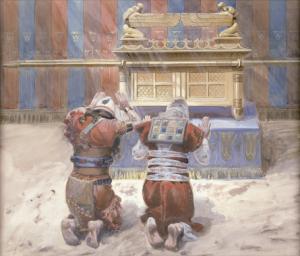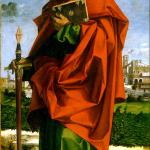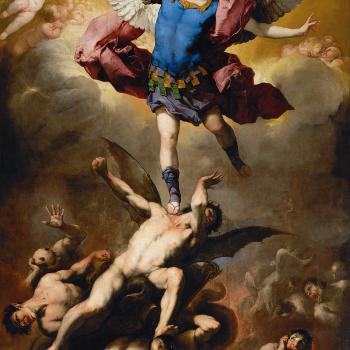
I am responding to portions of anti-Catholic evangelical apologist Eric Svendsen’s “In the Image of God: A Dialogue With a Roman Catholic Apologist on the Veneration of Images” (dated not long before 13 May 2007). His words will be in blue.
*****
Clearly, the Scriptures consider bowing before images an act of worship.
“You shall not make for yourself an idol in the form of anything in heaven above or on the earth beneath or in the waters below. You shall not bow down to them or worship them; for I, the LORD your God, am a jealous God” (Exod 20:4-5).
The passage does not indicate that it is acceptable before God to bow down to an image so long as it does not represent deity and you do not consider it deity. Rather, it states unequivocally not to make an image of “anything,” in heaven or on earth, with the purpose of “bowing down” to it. Indeed, the very point of the passage is that God alone is to receive this kind of honor (more on this later).
Both the Hebrew (pesel) and the Greek LXX (eidōlon) simply mean “image.” This could be of a false god (idol), but neither the word itself nor the context of Exodus 20 limits it to that application. The word translated “anything” (Gr., pantos, “all”; Heb., kol, “the whole of”) is categorical. In Hebrew, kol is used to signify “the entire class” (BDB), and with the negative, “none in the entire class.” The LXX borrows the Hebrew idiom by using pantos with the negative. It is a categorical prohibition against bowing down to any and all religious images. It allows for no exceptions. . . .
Roman Catholic[s] will argue that veneration of the saints is not worship, [but] such a claim is simply gratuitous. What is gratuitously asserted may be gratuitously denied. . . . I maintain that bowing down to, praying to, and kissing the feet of any image is indeed an act of worship.
Clearly, this is dead wrong, and it’s easy to show this from Scripture.
Joshua 7:6-7 (RSV) Then Joshua rent his clothes, and fell to the earth upon his face before the ark of the LORD until the evening, he and the elders of Israel; and they put dust upon their heads. [7] And Joshua said, “Alas, O Lord GOD, why hast thou brought this people over the Jordan at all, to give us into the hands of the Amorites, to destroy us? Would that we had been content to dwell beyond the Jordan!”
The ark of the covenant — the most sacred item to the ancient Israelites — had cherubim carved on top of it: on both sides of the “mercy seat” (Ex 25:22; Num 7:89; Heb 9:5). Additionally, when the ark was put into its permanent place in the Holy of Holies in the temple, giant carved cherubim covered it as well (1 Kgs 6:23 ff.; 8:6-7; 1 Chr 28:18; 2 Chr 3:11 ff.; 5:8).
We know that cherubim represented (and in carved images portrayed) angels. We know that they were on top of the ark of the covenant itself, and also in larger form, present in the temple, covering the entire ark. We also know that they were present in the temple outside of the Holy of Holies, also previously in the tabernacle, in engraved or embroidered images (Ex 26:31; 1 Kgs 6 and 7; Ezek 41:18 ff.).
[see also an illustration of Solomon’s temple and what the ark of the covenant may have looked like]
This being the case, we know that wherever there is bowing, prayer, and/or worship in Scripture, as related to the ark of the covenant either outside the temple or tabernacle, or in them, that statues (of cherubim / angels) were present. And this is also true of any bowing, prayer, and/or worship in or near the temple. That’s an awful lot of statuary or other images! Yet we are to believe that these most sacred acts of the ancient Jews were fundamentally idolatrous, and that anything even approximating these actions in Christianity is also idolatrous? It strains credulity to the breaking point.
The ancient Israelites also worshiped, praised, and sacrificed before the ark of the covenant:
1 Kings 8:5 And King Solomon and all the congregation of Israel, who had assembled before him, were with him before the ark, sacrificing so many sheep and oxen that they could not be counted or numbered. (cf. 2 Chr 5:6)
1 Chronicles 16:4 Moreover he appointed certain of the Levites as ministers before the ark of the LORD, to invoke, to thank, and to praise the LORD, the God of Israel. (cf. Deut 10:8)
1 Chronicles 16:37 So David left Asaph and his brethren there before the ark of the covenant of the LORD to minister continually before the ark as each day required,
Moreover, they bowed towards the temple (which included carved and painted cherubim), and worshiped and gave thanks:
2 Chronicles 7:3 When all the children of Israel saw the fire come down and the glory of the LORD upon the temple, they bowed down with their faces to the earth on the pavement, and worshiped and gave thanks to the LORD, saying, “For he is good, for his steadfast love endures for ever.”
Psalm 138:2 I bow down toward thy holy temple and give thanks to thy name for thy steadfast love and thy faithfulness; for thou hast exalted above everything thy name and thy word. (cf. Lk 2:37; Heb 9:2-7)
2 Chronicles 6:20 that thou mayest hearken to the prayer which thy servant offers toward this place.*2 Chronicles 6:26-27 When heaven is shut up and there is no rain because they have sinned against thee, if they pray toward this place, and acknowledge thy name, and turn from their sin, when thou dost afflict them, [27] then hear thou in heaven, and forgive the sin of thy servants, thy people Israel, when thou dost teach them the good way in which they should walk; and grant rain upon thy land, which thou hast given to thy people as an inheritance.
*2 Chronicles 6:29-30 whatever prayer, whatever supplication is made by any man or by all thy people Israel, each knowing his own affliction, and his own sorrow and stretching out his hands toward this house; [30] then hear thou from heaven thy dwelling place, and forgive, and render to each whose heart thou knowest, according to all his ways (for thou, thou only, knowest the hearts of the children of men);
*2 Chronicles 6:32-33 Likewise when a foreigner, who is not of thy people Israel, comes from a far country for the sake of thy great name, and thy mighty hand, and thy outstretched arm, when he comes and prays toward this house, [33] hear thou from heaven thy dwelling place, (cf. 1 Kgs 29-30, 35, 42)*Psalm 5:7 . . . I will worship toward thy holy temple in the fear of thee.
*Psalm 28:2 Hear the voice of my supplication, as I cry to thee for help, as I lift up my hands toward thy most holy sanctuary.Psalm 134:2 Lift up your hands to the holy place, and bless the LORD!
Context makes it very clear that idolatry is being condemned. The next verse states: “You shall not bow down to them or worship them” (NIV, NRSV). In other words, mere blocks of stone or wood (“them”) are not to be worshiped, as that is gross idolatry, and the inanimate objects are not God. This does not absolutely preclude, however, the notion of an icon, where God is worshiped with the help of a visual aid.
Idolatry is a matter of disobedience in the heart towards the one true God. We don’t always need an image to have an idol. Most idols today are non-visual: money, sex, lust for power, convenience, our own pride or intellects; there are all sorts of idols. Anything that replaces God as the most important thing in our life and the universe, is an idol. Idolatry is also a “heart issue.”
Did Solomon or any of the Israelites bow down and pray to these images [of the cherubim in the temple]?
Yes, as proven above from Holy Scripture.
Obviously not. Scripture indeed makes a distinction, . . . The distinction is rather between making a religious image, and making a religious image with the purpose of bowing down to that image. Scripture never commends the latter; yet this is exactly what Roman Catholics do with their images. . . .
Moreover, one is struck by the complete lack of precedent in Scripture of anyone known to be in good standing with God bowing down to a statue of anything, whether of a god or a “non god.”
It does indeed “commend” bowing down to created images connected to the ark, tabernacle and temple. Svendsen shows himself quite remarkably biblically illiterate.
Related Reading
“Graven Images”: Unbiblical Iconoclasm (vs. John Calvin) [Oct. 2012]
Biblical Idolatry: Authentic & Counterfeit Conceptions [2015]
Was Moses’ Bronze Serpent an Idolatrous “Graven Image?” [National Catholic Register, 2-17-20]
***
Photo credit: Moses and Joshua in the Tabernacle, c. 1896-1902, by James Tissot (1836-1902) [public domain / Wikimedia Commons]
***













